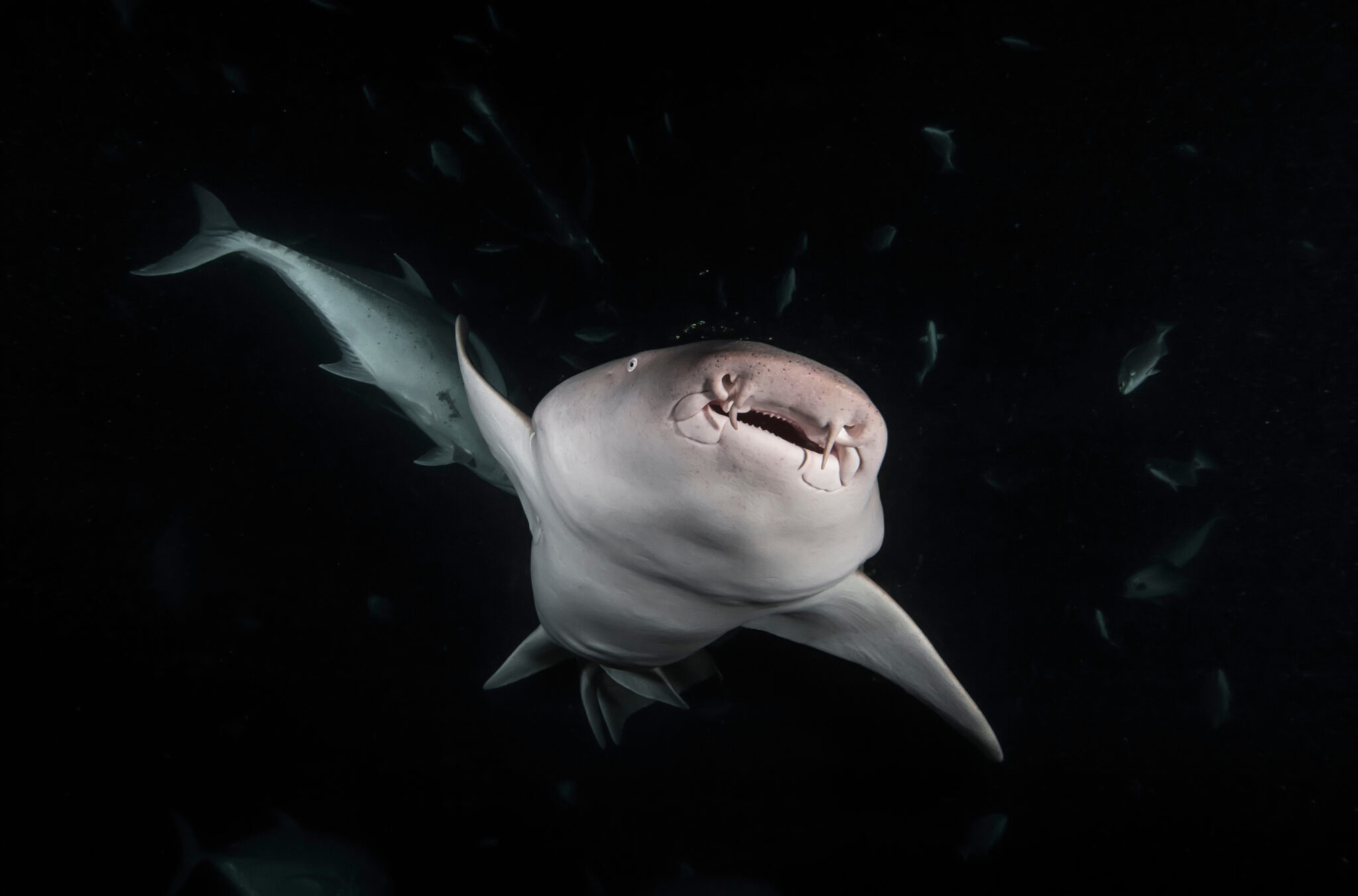Tawny nurse shark
Nebrius ferrugineus



This relatively docile shark, also known as the ‘giant sleepy shark’, is a favourite with divers. They are nocturnal and mainly rest during the day, either lying on the sand or huddled together in their favourite rock crevices and caves. By night, they hunt along the seabed, using a powerful, muscular pharynx to suck prey out of hiding places in the reef.
IDENTIFICATION
Large, ‘bulky’ body with broad, flattened head and square-ish snout. Two long barbels in front of the nostrils and small spiracles behind the eyes. Mouth located well in front of eyes. Teeth small and comb-like. Fins long and angular; caudal fin can be over a quarter of its total body length. Large first dorsal fin located further back along the body, over the pelvic fin bases. Varying shades of brown depending on location. Very similar in appearance to the nurse shark Ginglymostoma cirratum, but can be distinguished by the more pointed pectoral, dorsal and anal fins as well as the narrow curve of its pectoral fins.

SPECIAL BEHAVIOUR
Tawny nurse sharks have a very limited home range, returning to the same sites every day to rest – sometimes even the exact same crevice or cave. Multiple individuals can share the same ‘favourite spot’ and may be found piled on top of each other.
REPRODUCTION
Reproduction seems to vary with location. In Australia, tawny nurse sharks have been recorded as aplacental viviparous, with litter sizes of 26 to 32 pups. However in Japan oophagy (embryos feeding on eggs) and much smaller litter sizes (1 to 4 pups) have been reported.
HABITAT AND GEOGRAPHICAL RANGE
Tawny nurse sharks are found on or near the seabed in sheltered sites, typically close to coral reefs, rocky reef edges, channels, seagrass habitats and lagoons. They have been found at depths of up to 70 m, but usually occur between 5–30 m. They have a widespread distribution in the tropical Indian and west and central Pacific Oceans, from southeast Africa to the Red Sea and Persian Gulf, India and east Asia to Japan in the north, and Australia to the Mashall islands and Tahiti.

DIET DESCRIPTION
Tawny nurse sharks feed on a variety of crustaceans, cephalopods (mainly octopus), sea urchins and reef fishes. They have also been known to occasionally feed on sea snakes.
THREATS
Tawny nurse sharks are fished throughout their range in industrial and small-scale longline, gillnet, trawl and handline fisheries. Their limited home range and propensity towards shallow waters makes them vulnerable to fishing pressure. It is rarely a target species as the meat and fins are considered of low value, and is mainly caught as by-catch. In regions such as India, Pakistan, Bangladesh, Myanmar, Indonesia, Sri Lanka and the Philippines it is sold for local consumption. In other regions it is targeted as a popular aquarium display species. Tawny nurse sharks are also fished recreationally as a gamefish in Australia. The tawny nurse shark’s reliance on coral reef habitats also makes it vulnerable to global climate change and habitat loss and degradation.
RELATIONSHIP WITH HUMANS
Considered a docile species, the tawny nurse shark is popular with divers and is a favourite tourism attraction in Thailand and the Solomon Islands. However, as a relatively large shark the tawny nurse should still be regarded with respect and has been known to bite if harassed. It is also a hardy, resilient species that adapts easily to captivity, and as such is a popular species for public aquaria.
CONSERVATION
While there are few species-specific management measures in place for this species, the tawny nurse shark benefits from more general conservation measures such as Marine Protected Areas (MPAs), which are common across its coral reef habitat. They may also be protected by more general measures to protect sharks, such as shark sanctuaries where targeted shark fishing is banned within the Exclusive Economic Zone (EEZ). Such measures are present in parts of the tawny nurse shark’s range, especially in the Pacific. However, further research is needed on the species’ population trends, life history and catch rates.
FUN FACTS
Adult tawny nurse sharks have their favourite hangout spots, and have been known to return to the exact same cave or crevice every day!
They may be famous for their docile nature, but can also put up quite a fight should the need arise. When caught, they have been observed ‘spitting’ streams of water, and even spinning on the line – which is possibly where the nickname ‘spitting shark’ comes from.
Their genus name Nebrius is from the Green ‘nebris, -idos’ which translates as ‘skin of a fawn’, referring to their brown colouration.
References
IUCN Red List of Threatened Species. 2021. Tawny nurse shark.
Ebert D.A. et al. 2021. Sharks of the World: A Complete Guide. Florida Museum. Discover fishes: Nebrius ferrugineus







